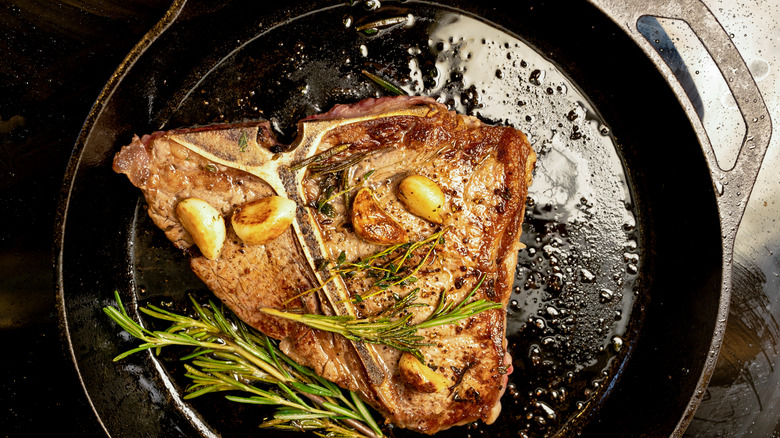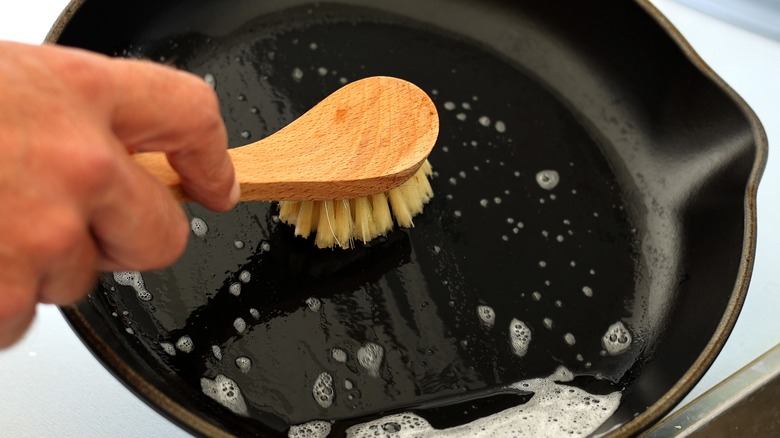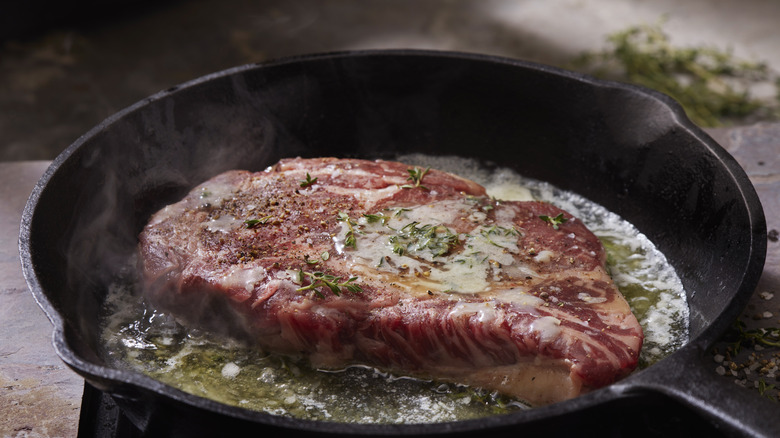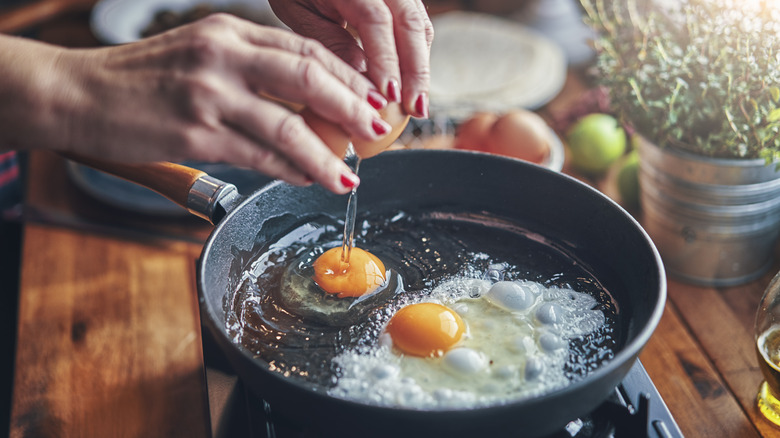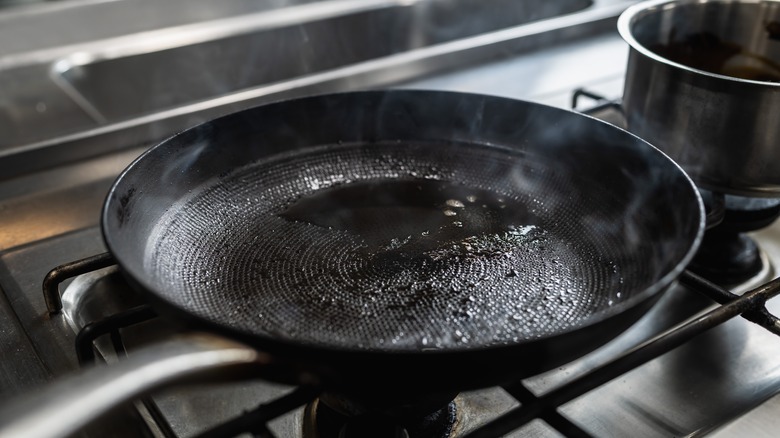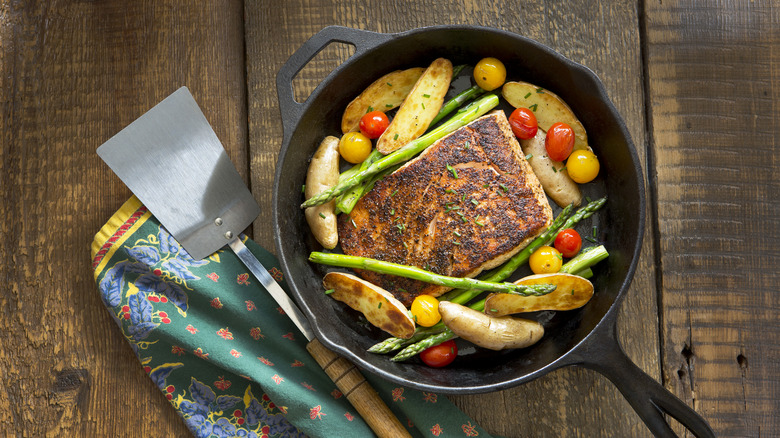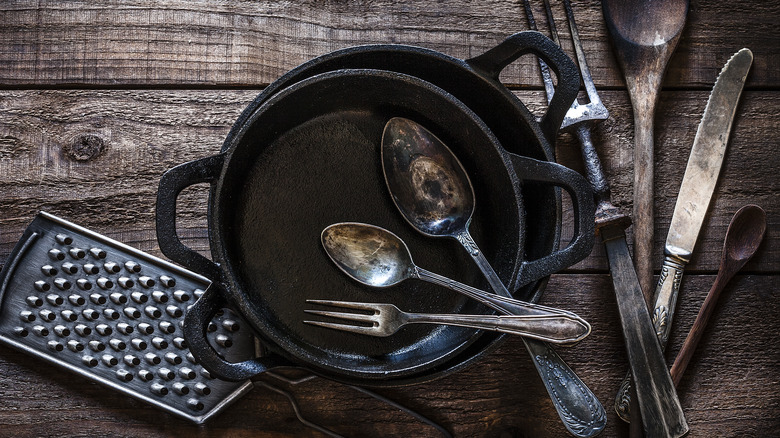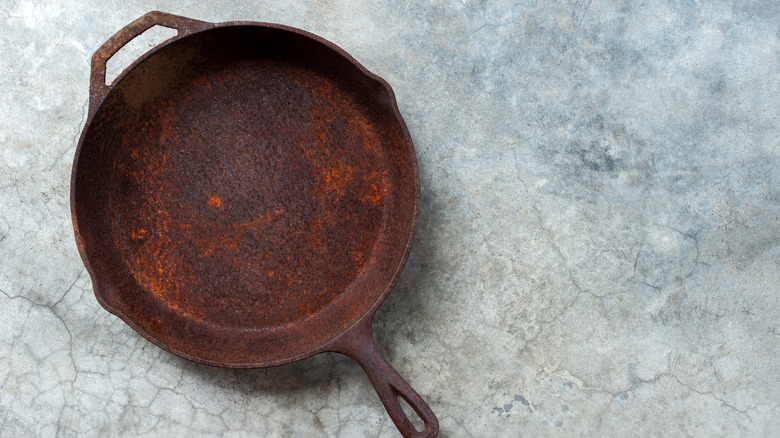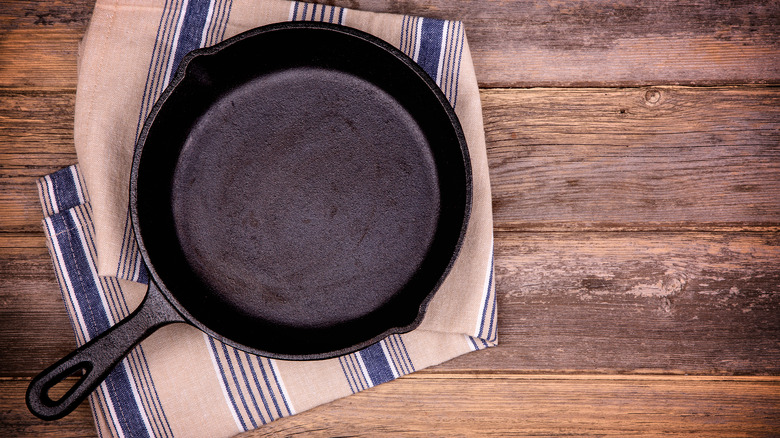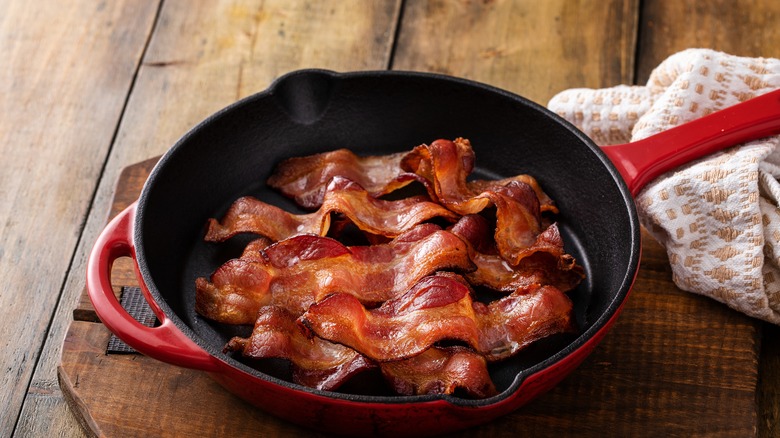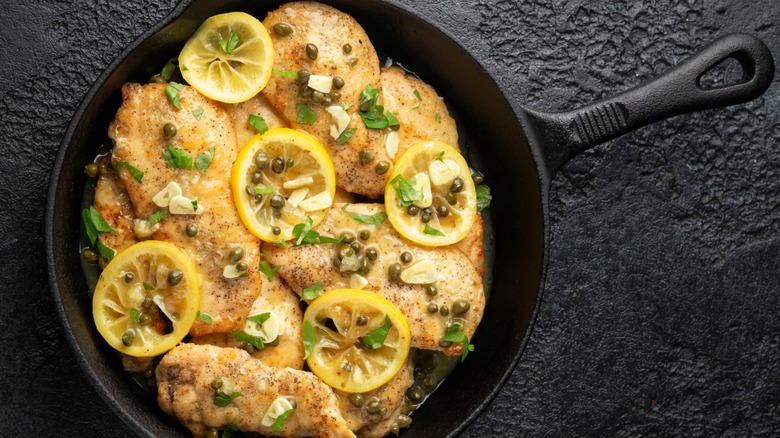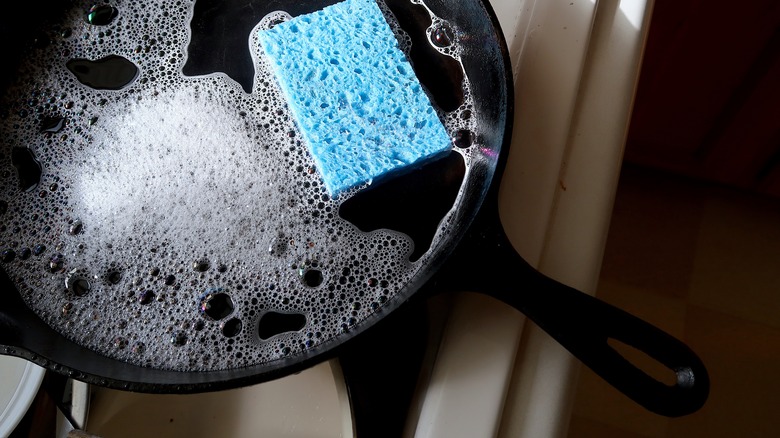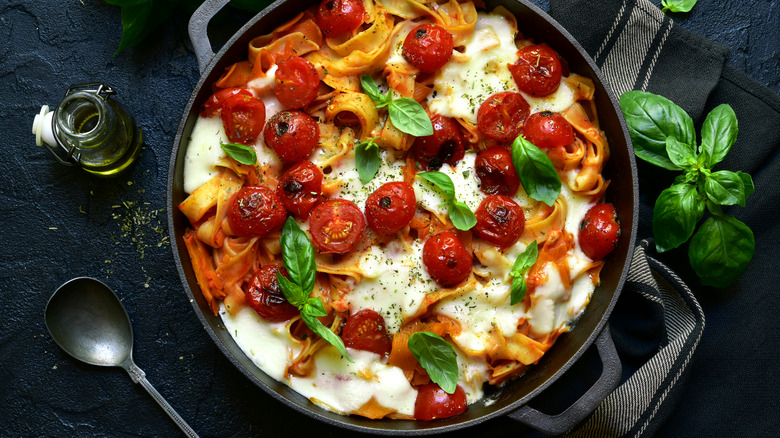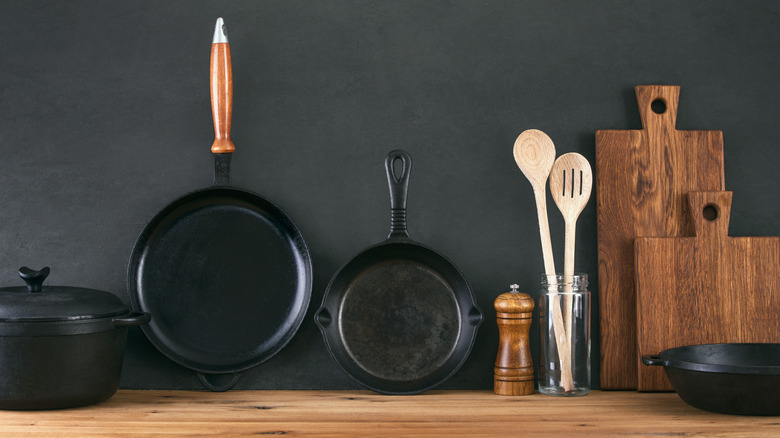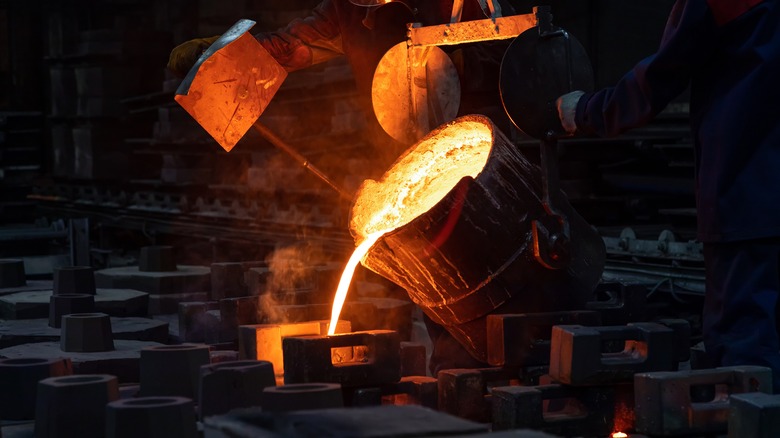15 Myths About Cast Iron Skillets, Debunked
Cast iron is one of the most durable and reliable cookware materials. It's been around for centuries, and the mere fact we're still using it shows how effective this kitchen tool is. A cast iron skillet is such a versatile piece of cookware that you can use for the perfect seared steak, fried eggs, sauteed vegetables, simmered wine sauce, and so much more. Whether you're just learning to cook or have years of experience, a sturdy cast iron skillet is essential for any chef.
Although cast iron skillets are widely used in professional and at-home kitchens, there is a lot of misinformation about these pans. Cast iron is a durable material that can last for decades, but it also takes specific care to maintain. Over the years, many myths about how to care for cast iron have been popularized and handed down from generation to generation. You've likely heard rules about how to wash cast iron, what to cook in cast iron, and how to preserve cast iron cookware. But a lot of it isn't true. We've researched some of the most common misconceptions about cast iron and are myth-busting them here.
1. Myth: You shouldn't wash cast iron with soap
It's a common myth that you should never clean your cast iron skillet with soap. The reason for this misconception is that scrubbing your skillet with dish soap will break down the seasoning, a thin layer of oil baked onto the pan that smooths the surface and keeps the pan from rusting. But the truth is you can wash your skillet with dish soap when needed. You just have to do it properly so as not to damage the seasoning or cause your pan to rust.
There are a few important tips to thoroughly wash your cast iron skillet without damaging it. First, it's best to wash while the pan is still warm. That way, food won't be hardened onto the surface, and you won't have to scrub as hard. Secondly, you only need a little dish soap and warm water. Then, gently scrub with a bristled brush or sponge until the food is removed. Be careful not to scratch the surface of the pan while Cleaning. After washing, make sure you thoroughly rinse off the soap and dry the pan before storing it to prevent it from rusting.
Note that although it's safe to wash your pan with soap, there are a few things you want to avoid. Don't put your pan in the dishwasher, scrub too harshly, or soak the pan in soapy water. All these cleaning methods can damage your pan.
2. Myth: Cast iron is unsafe to use
You may have been warned of the dangers of cooking with cast iron, such as transferring iron to your food or causing cancer. These worries may have even kept you from making some of the delicious recipes you can prepare in a cast iron skillet. Instead of letting false claims keep you from easy cooking and amazing food, it's time to get to the bottom of these myths.
Many people believe that because cast iron is made of iron, the pans transfer iron to your food while cooking. This is somewhat true. However, the amount of iron transferred to your food from cast iron is typically minimal and perfectly safe. As long as your cast iron skillet is seasoned, it won't be transferring a high amount of iron to your meals. So, as long as you don't have a compounding health condition that makes iron more dangerous for you, the small amount that may transfer to your food is of little concern.
Another worry is that the high temperatures often used with cast iron cooking may produce carcinogens. However, Abbie Gellman, RD, CDN, told LiveStrong that these types of carcinogens are more often found after grilling meats. "They [cast-iron pans] can withstand high heat, but that doesn't mean you are cooking stovetop or in an oven at a temperature that is high enough to be concerned with carcinogens," Gellman explained.
3. Myth: Cast iron skillets are non-stick
People often think of cast iron skillets as a non-stick cooking surface. And it's true that due to the layer of seasoning, cast iron is easier to work with than many other types of cookware. As long as the pan is well seasoned, you often won't have to worry about foods like chicken or steak sticking to cast iron while you cook. However, if you've ever tried to cook eggs or other sticky foods in a cast iron skillet without any oil, you've likely seen for yourself that cast iron is not really non-stick.
Skillets and saucepans that are designed with a non-stick surface are coated in a layer of polytetrafluoroethylene (PTFE), more commonly called Teflon. This substance allows foods to slide over the surface without gripping onto it, so you don't have to worry about stuck-on bits of food. Cast iron is not made with Teflon. So, although well-seasoned cast iron is easy to cook with, you'll likely have to add a little oil before cooking to keep your food from sticking. While it may stick to some food less than others the truth about cast iron is that it's not a non-stick pan.
4. Myth: Cast iron pans always heat evenly
Although cast iron skillets retain heat wonderfully, that doesn't mean these pans heat evenly. The sturdy cast iron material is not a good heat conductor, so heat doesn't travel well through the pan. This means that if you're using a standard-sized kitchen burner, your cast iron skillet will get very hot on the portions right above the burner. But, you may notice the edges and parts of the pan not directly above your burner take longer to heat.
Adding food to your cast iron skillet before it's evenly heated can result in uneven cooking and ruin the crispy sear you want. To avoid this, it's best to preheat your skillet. Simply place your skillet over medium heat for several minutes before cooking. To help the heat reach all portions of the pan, you can turn it and shift its placement over the burner during the preheating time. Once the pan becomes warm, add oil and spread it evenly over the surface. Then, let the oil heat before adding your food and beginning to cook. Taking the extra time to preheat the pan may feel like a hassle, but it's an essential step to making amazing, crispy recipes in your cast iron skillet.
5. Myth: You should never use metal on cast iron
It's a common myth that you should not use metal on cast iron skillets. Many people believe that using a metal spatula will scratch the surface of your cast iron pan, which can lead to rusting and shorten the life of your skillet. But, in truth, cast iron cookware is quite durable. A well-seasoned cast iron skillet will hold up just fine to metal utensils. One of the great things about cooking with cast iron is that you can use just about any of your standard cooking utensils on it. Wooden, silicon, and metal tools are all safe for this type of pan.
Now, while you can use metal on your cast iron pan, there are still a few tips to keep in mind to avoid damaging your pan. The first is not to scrape the pan too aggressively. Although cast iron is strong, it's best to treat it with care. Harsh scraping will damage the seasoning and can mar the pan. Secondly, make sure your pan is well seasoned. The layer of seasoning acts as protection between the pan and your metal utensil, so you're less likely to scratch the skillet. Seasoning also helps prevent food from sticking, so harsh scraping won't be as necessary with any tool.
6. Myth: You should soak your cast iron skillet
Yet another myth that people consider standard practice is that you should soak your cast iron skillet to wash it. After preparing their meal, many cooks add water to their skillet and leave the pan to soak. It's thought of as the gentlest way to remove stuck-on food. The hope is that letting the water soften the food makes it easy to wipe the skillet clean without scraping it. For particularly messy dishes, you'll see people soaking their skillet for hours or even overnight rather than washing it. But you should never soak your cast iron skillet. Rather than avoiding damage, soaking your skillet for a long time can be one of the worst things for it.
Because cast iron is a porous material, you need to be careful to keep it from rusting. Although soaking your pan in water may seem harmless, left for a long time, the cast iron will start to absorb the water, which causes the metal to rust. That's why it's much smarter to wash your skillet by hand, using dish soap if necessary. Although this may be the opposite of what you've been taught, washing your skillet is far better than leaving it to soak.
7. Myth: Throw out your cast iron skillet if it rusts
Because of the porous nature of cast iron, the pans will often rust over time. You can do your best to avoid this and keep your cast iron fresh by gently cleaning and carefully drying the pan. However, even well-cared-for skillets may eventually rust. This can be disheartening, especially if you've spent a lot of money on the pan and tried to keep it in good condition. But don't give up on your pan. Despite what you may have heard, a little rust is not a reason to toss out your skillet.
One of the many benefits of these skillets is how durable they are. A good cast iron pan can last for decades. If your pan has some rust, you can take a few easy steps to restore the metal and keep cooking for years to come. You can try using a steel wool sponge to scrape the rusted portions off the pan. You typically want to avoid harshly scraping your cast iron pan like this, but it's necessary to remove the rust. If only a small section has rusted, only scrape that part of the pan. Once you've scrubbed off the rust, wash the pan with soap and warm water and dry it thoroughly. Scraping off the rust will damage the pan's seasoning, so it's important to re-season your cast iron before cooking with it again.
8. Myth: You don't need to worry about re-seasoning
As discussed, seasoning is a layer of oil baked onto the surface of your cast iron skillet. This seasoning acts as a protective layer, which helps prevent rusting and scrapes on the pan's surface. It also makes the skillet semi-nonstick. Most cast iron pans you buy today are pre-treated, with this layer of oil already baked to the surface for easy cooking. With that treatment done, you may think that you can continue to cook with the pan as it is indefinitely. However, that's not true. Seasoning has to be maintained. Even if you buy a pre-treated cast iron pan, re-seasoning the skillet is an essential step in cast iron maintenance.
To season your cast iron skillet, ensure your pan is clean and dry, and preheat your oven to 350 F. Then, use a brush or paper towel to add a light layer of cooking oil over the entire pan. It's important to spread the oil in a thin, even layer, carefully avoiding any pooling drops or blank spots. After applying the oil, place the coated pan in the preheated oven for an hour. Once it cools, you'll have a beautifully seasoned cast iron skillet ready to cook. How often you need to re-season your pan depends on how often you use it. You likely want to go through this process about once a month.
9. Myth: You need to spend a lot of money on your skillet
Since cast iron skillets are such an essential tool in your kitchen, you may think you need to spend big money to get a sturdy, long-lasting pan. But, despite what the marketing from high-end brands may say, you really don't need to spend a lot of money on your cast iron pan. Because cast iron pans are all made from the same durable material, buying a high-end brand isn't required to get good-quality cookware.
Depending on the brand, you can find skillets ranging from as low as $20 to well over $100. The plethora of options can make picking your skillet difficult, but the good news is it also means you can find a skillet that works for your budget. In fact, Lodge is one of the most popular brands of cast iron cookware, and you can purchase a standard 10.25-inch skillet for just over $20. So, don't be fooled by anyone saying you need to get an expensive skillet. There's no need to skip this versatile kitchen tool just because you're on a budget.
10. Myth: You shouldn't cook acidic food
Another false thing you may have heard about cooking with cast iron is that you should never cook acidic food in your skillet. This applies to cooking dishes using lots of tomato sauce, wine, lemon juice, and other heavily acidic ingredients. The concern is that the acidity breaks down the pan surface, causing minerals to get absorbed into your food, leading to a metallic taste, health impacts, and damage to your pan.
While it's true that acidic food can break down your cast iron over time, the good news is that you can follow a few guidelines to avoid these effects. When picking what recipes you'll cook in your skillet, remember that acidic ingredients will take time to damage the pan. If you're searing or quickly cooking an acidic recipe, this isn't a big concern. It's best to find another cooking vessel for acidic recipes that call for more than 45 minutes of cooking time. It's also important to make sure you're using a well-seasoned pan and take care of the pan after cooking. Instead of waiting for clean up, rinse out and dry the pan as soon as you can. That way, the acidic ingredients don't have time to sit in the skillet for too long. After you've cooked, an acidic meal is a good time to reseason your skillet before cooking again.
11. Myth: You should never wash your cast iron skillet
This myth likely stems from the common belief that you shouldn't use dish soap on your skillet, causing some to take it a step further and say you shouldn't wash your cast iron skillet at all. The fear of dish soap, coupled with the fact that you shouldn't soak cast iron, have left many home chefs to simply scrape stuck-on food off of their pan before putting it back in the cupboard.
This practice is far from sanitary and can shorten the lifespan of your cast iron. Never washing your pan can leave remnants of food building up every time you cook. This can attract pests to your kitchen, which nobody wants. The food remnants can also cause your pan to rust and lead to uneven cooking. The belief that you should never wash cast iron skillet is simply false. As long as you're careful to wash your skillet gently and rinse and dry it thoroughly, that's the best way to care for cast iron.
12. Myth: You can only use cast iron on gas stovetops
If you've ever heard that cast iron skillets should only be used over gas stoves, this is another myth. Don't let this false fact stop you from taking full advantage of this durable cookware. It is true that because cast iron can withstand high heat, it's an ideal material to cook over a gas stove. However, you can also use it on an electric stovetop. Regardless of your stove type, a cast iron is an excellent pan for searing, frying, and simmering your favorite dishes.
Many recipes you think of using a cast iron skillet for, like fried chicken, steak, buttermilk pancakes, and eggs, are prepared on the stovetop. But cast iron is a very tough material that also does great in the oven. Putting cast iron in the oven is an excellent way to make crowd-pleasing dishes like homemade pizza, chicken pot pie, and Dutch babies. You can even place your cast iron pan over a grill for some outdoor cooking.
13. Myth: You can't overseason a skillet
There exists a widespread belief that it's hard to season a cast iron pan correctly. That's not true at all, and in fact, many pans come already seasoned. However, this misunderstanding has led to many people taking one of two approaches: avoiding cast iron altogether or overseasoning it. The latter represents its own myth — while many people think it's impossible, the truth is that you can indeed overseason cast iron.
To understand this, it's helpful to know how seasoning works. Essentially, when you season a cast iron pan properly, you're baking oil into the surface of the metal, which is called polymerization. This carbonized oil builds up over time, bonding to the pan and resulting in that shiny black finish that everyone prizes in old, well-cured cast iron. However, if you apply too much oil to the pan, it can develop a sticky surface layer, which isn't good for easy-release cooking. This is especially likely to happen on the bottom, where people often don't wash as carefully and therefore fail to remove all the excess oil.
Also, if you apply too much oil without baking it in, either on the stovetop or in the oven, it may be only loosely bonded and begin to flake off. This can also happen if you season with a low-smoke point oil. Cast iron can get flaky for other reasons, such as poor care or not using the skillet often enough to build up the polymerization layer.
14. Myth: Vintage cast iron pans are way better
People like vintage cast iron pans for two reasons: either they are generally vintage fans, or they believe that vintage pans are better nonstick options. There is truth behind this, because vintage pans are more likely (but certainly not guaranteed) to have a nice cure on them than brand-new pans, even those that come preseasoned. While preseasoned pans have oil baked into them, they don't have that glassy smooth finish yet. That takes time, which can vary greatly depending on how often you use the pan (thus helping cook oil into its surface).
Perhaps you're just getting into cast iron and want to skip the seasoning phase. Or maybe you simply think vintage is a better cooking experience, as some chefs do. Whatever the case, there are a few things you ought to know. First of all, "vintage" means anything between 20 and 100 years old. (Older than 100 is antique.) If you like antiquing, you can look for pans yourself; the proprietor should be able to tell you or at least closely guess the age of the pan. If they can't, skip it.
Second of all, when shopping yourself, look for pans with a nice, smooth surface. When you run your finger along it, it should feel like glass, not worn-down sandpaper. Avoid warping, cracking, and pitting. Or you can just skip the hassle and buy vintage online or from a dealer.
15. Myth: Cast iron skillets are indestructible
While cast iron is pretty darn beastly, it's not made of diamond. (If it were, this writer would have a lot more financial stability.) As such, you can break cast iron pans. The reason this is so boils down to the atomic makeup of different metals.
Essentially, metals and alloys (mixes of metal) are different in their structure on a molecular or atomic level. Some metals consist of layers of atoms that are capable of sliding across one another if the metal is bent, pressed, or otherwise stressed. This includes soft metals such as gold, silver, and copper, which all have this characteristic. However, other metals are not malleable and as such do not respond to stress by bending. These include tungsten, titanium, and ... you guessed it ... cast iron.
Unlike its cousins wrought iron and steel, cast iron is made by pouring liquid iron into a mold rather than being hammered or worked. None of the three are made of pure elemental iron (Fe or 26 on the periodic table), all containing other elements. However, cast iron's alloy mix and the production process lead to a product that is very strong but highly brittle, meaning that it will not bend — it will break. As such, you'll need to work harder not to drop, smash, or torque cast iron pans than you would with stainless steel or copper, because they might not survive.
